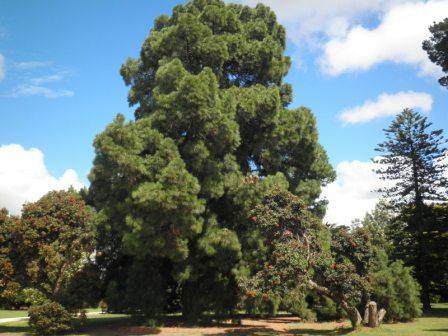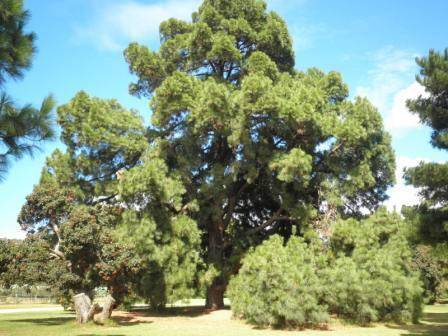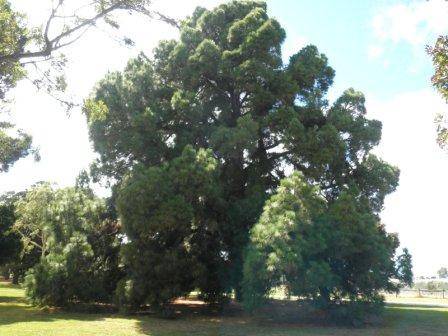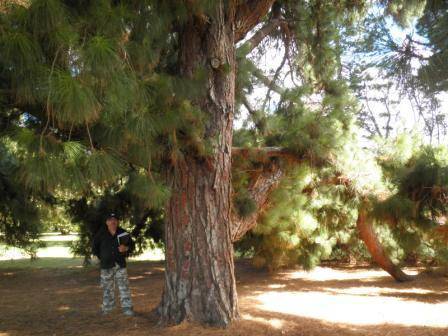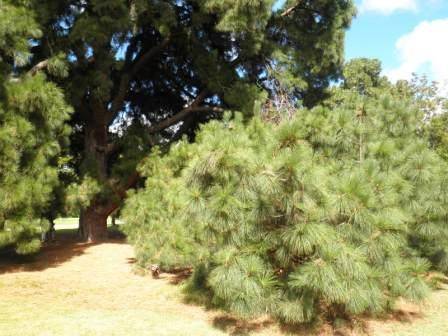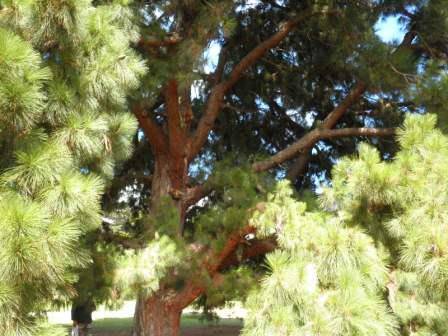| Back to search results » | Back to search page » |
|
Pinus canariensis
Statement of Significance
What is significant?
Contribution to landscape of historic garden
Outstanding size
Aesthetic value
Curious growth form
Historical value
Outstanding example of species
This Canary Islands Pine (Pinus canariensis), located at the south-east corner of the Werribee Park Mansion garden, represents one of the three species of pine used extensively by the Chirnsides in the planting of the garden and throughout the property. This late nineteenth century specimen was selected and planted circa 1877 by the gardeners employed by Thomas Chirnside. It typifies the botanical material available in the nineteenth century and Pinus species were commonly used in the layout of botanic gardens, large private estates and arboretums alike. Its use highlights a historic planting style for large gardens and estates. Planted at the south-east corner of the garden and across the expanse of the Great Lawn in front of the mansion its function was not only ornamental, but a windbreak, a screen for privacy and as a landmark in the distance of the European essence of the garden.
The Chirnside Family's contribution to Victoria's pastoral and agricultural growth is notable as leaders and pioneers of the colony's pastoral industry. Their vast land holdings in Victoria, New South Wales, South Australia and Queensland made them one of the wealthiest families in the colony. The grandeur of their influence and wealth is reflected in their opulent Roman Renaissance Revival style mansion at Werribee Park and is stately garden.
The canopy of this specimen is unique within the species in that a large lower limb fractured many years ago and healed and continues to grow along the ground outwards from the tree. This specimen's canopy rests on the ground and rises almost 26 metres high. It has developed on a tall leader trunk and spreads its vast canopy outwards. It is typical of the type of foliage and architectural form that nineteenth century garden enthusiasts with large rural estates collected and introduced to give their new homeland a 'European' essence and feel.
Outstanding size
Aesthetic value
Curious growth form
Historical value
Outstanding example of species
This Canary Islands Pine (Pinus canariensis), located at the south-east corner of the Werribee Park Mansion garden, represents one of the three species of pine used extensively by the Chirnsides in the planting of the garden and throughout the property. This late nineteenth century specimen was selected and planted circa 1877 by the gardeners employed by Thomas Chirnside. It typifies the botanical material available in the nineteenth century and Pinus species were commonly used in the layout of botanic gardens, large private estates and arboretums alike. Its use highlights a historic planting style for large gardens and estates. Planted at the south-east corner of the garden and across the expanse of the Great Lawn in front of the mansion its function was not only ornamental, but a windbreak, a screen for privacy and as a landmark in the distance of the European essence of the garden.
The Chirnside Family's contribution to Victoria's pastoral and agricultural growth is notable as leaders and pioneers of the colony's pastoral industry. Their vast land holdings in Victoria, New South Wales, South Australia and Queensland made them one of the wealthiest families in the colony. The grandeur of their influence and wealth is reflected in their opulent Roman Renaissance Revival style mansion at Werribee Park and is stately garden.
The canopy of this specimen is unique within the species in that a large lower limb fractured many years ago and healed and continues to grow along the ground outwards from the tree. This specimen's canopy rests on the ground and rises almost 26 metres high. It has developed on a tall leader trunk and spreads its vast canopy outwards. It is typical of the type of foliage and architectural form that nineteenth century garden enthusiasts with large rural estates collected and introduced to give their new homeland a 'European' essence and feel.
Measurements: 12/02/2012
Spread (m): E-W 26;N-S 24
Girth (m): 3.6 at 1.4 above ground level
Height (m): 25.7
Estimated Age (yrs): 135
Condition: Excellent
Measurements: 08/12/2022
Spread (m): N-S 24.1, E-W 24.8
Girth (m): 3.7 at 1.0 above ground level
Height (m): 26.7
Condition: Excellent
Spread (m): E-W 26;N-S 24
Girth (m): 3.6 at 1.4 above ground level
Height (m): 25.7
Estimated Age (yrs): 135
Condition: Excellent
Measurements: 08/12/2022
Spread (m): N-S 24.1, E-W 24.8
Girth (m): 3.7 at 1.0 above ground level
Height (m): 26.7
Condition: Excellent
Access: Unrestricted
Classified: 28/05/2012
Classified: 28/05/2012
How is it significant?
Contribution to landscape of historic garden
Outstanding size
Aesthetic value
Curious growth form
Historical value
Outstanding example of species
This Canary Islands Pine (Pinus canariensis), located at the south-east corner of the Werribee Park Mansion garden, represents one of the three species of pine used extensively by the Chirnsides in the planting of the garden and throughout the property. This late nineteenth century specimen was selected and planted circa 1877 by the gardeners employed by Thomas Chirnside. It typifies the botanical material available in the nineteenth century and Pinus species were commonly used in the layout of botanic gardens, large private estates and arboretums alike. Its use highlights a historic planting style for large gardens and estates. Planted at the south-east corner of the garden and across the expanse of the Great Lawn in front of the mansion its function was not only ornamental, but a windbreak, a screen for privacy and as a landmark in the distance of the European essence of the garden.
The Chirnside Family's contribution to Victoria's pastoral and agricultural growth is notable as leaders and pioneers of the colony's pastoral industry. Their vast land holdings in Victoria, New South Wales, South Australia and Queensland made them one of the wealthiest families in the colony. The grandeur of their influence and wealth is reflected in their opulent Roman Renaissance Revival style mansion at Werribee Park and is stately garden.
The canopy of this specimen is unique within the species in that a large lower limb fractured many years ago and healed and continues to grow along the ground outwards from the tree. This specimen's canopy rests on the ground and rises almost 26 metres high. It has developed on a tall leader trunk and spreads its vast canopy outwards. It is typical of the type of foliage and architectural form that nineteenth century garden enthusiasts with large rural estates collected and introduced to give their new homeland a 'European' essence and feel.
Outstanding size
Aesthetic value
Curious growth form
Historical value
Outstanding example of species
This Canary Islands Pine (Pinus canariensis), located at the south-east corner of the Werribee Park Mansion garden, represents one of the three species of pine used extensively by the Chirnsides in the planting of the garden and throughout the property. This late nineteenth century specimen was selected and planted circa 1877 by the gardeners employed by Thomas Chirnside. It typifies the botanical material available in the nineteenth century and Pinus species were commonly used in the layout of botanic gardens, large private estates and arboretums alike. Its use highlights a historic planting style for large gardens and estates. Planted at the south-east corner of the garden and across the expanse of the Great Lawn in front of the mansion its function was not only ornamental, but a windbreak, a screen for privacy and as a landmark in the distance of the European essence of the garden.
The Chirnside Family's contribution to Victoria's pastoral and agricultural growth is notable as leaders and pioneers of the colony's pastoral industry. Their vast land holdings in Victoria, New South Wales, South Australia and Queensland made them one of the wealthiest families in the colony. The grandeur of their influence and wealth is reflected in their opulent Roman Renaissance Revival style mansion at Werribee Park and is stately garden.
The canopy of this specimen is unique within the species in that a large lower limb fractured many years ago and healed and continues to grow along the ground outwards from the tree. This specimen's canopy rests on the ground and rises almost 26 metres high. It has developed on a tall leader trunk and spreads its vast canopy outwards. It is typical of the type of foliage and architectural form that nineteenth century garden enthusiasts with large rural estates collected and introduced to give their new homeland a 'European' essence and feel.
Measurements: 12/02/2012
Spread (m): E-W 26;N-S 24
Girth (m): 3.6 at 1.4 above ground level
Height (m): 25.7
Estimated Age (yrs): 135
Condition: Excellent
Measurements: 08/12/2022
Spread (m): N-S 24.1, E-W 24.8
Girth (m): 3.7 at 1.0 above ground level
Height (m): 26.7
Condition: Excellent
Spread (m): E-W 26;N-S 24
Girth (m): 3.6 at 1.4 above ground level
Height (m): 25.7
Estimated Age (yrs): 135
Condition: Excellent
Measurements: 08/12/2022
Spread (m): N-S 24.1, E-W 24.8
Girth (m): 3.7 at 1.0 above ground level
Height (m): 26.7
Condition: Excellent
Access: Unrestricted
Classified: 28/05/2012
Classified: 28/05/2012
Why is it significant?
Contribution to landscape of historic garden
Outstanding size
Aesthetic value
Curious growth form
Historical value
Outstanding example of species
This Canary Islands Pine (Pinus canariensis), located at the south-east corner of the Werribee Park Mansion garden, represents one of the three species of pine used extensively by the Chirnsides in the planting of the garden and throughout the property. This late nineteenth century specimen was selected and planted circa 1877 by the gardeners employed by Thomas Chirnside. It typifies the botanical material available in the nineteenth century and Pinus species were commonly used in the layout of botanic gardens, large private estates and arboretums alike. Its use highlights a historic planting style for large gardens and estates. Planted at the south-east corner of the garden and across the expanse of the Great Lawn in front of the mansion its function was not only ornamental, but a windbreak, a screen for privacy and as a landmark in the distance of the European essence of the garden.
The Chirnside Family's contribution to Victoria's pastoral and agricultural growth is notable as leaders and pioneers of the colony's pastoral industry. Their vast land holdings in Victoria, New South Wales, South Australia and Queensland made them one of the wealthiest families in the colony. The grandeur of their influence and wealth is reflected in their opulent Roman Renaissance Revival style mansion at Werribee Park and is stately garden.
The canopy of this specimen is unique within the species in that a large lower limb fractured many years ago and healed and continues to grow along the ground outwards from the tree. This specimen's canopy rests on the ground and rises almost 26 metres high. It has developed on a tall leader trunk and spreads its vast canopy outwards. It is typical of the type of foliage and architectural form that nineteenth century garden enthusiasts with large rural estates collected and introduced to give their new homeland a 'European' essence and feel.
Outstanding size
Aesthetic value
Curious growth form
Historical value
Outstanding example of species
This Canary Islands Pine (Pinus canariensis), located at the south-east corner of the Werribee Park Mansion garden, represents one of the three species of pine used extensively by the Chirnsides in the planting of the garden and throughout the property. This late nineteenth century specimen was selected and planted circa 1877 by the gardeners employed by Thomas Chirnside. It typifies the botanical material available in the nineteenth century and Pinus species were commonly used in the layout of botanic gardens, large private estates and arboretums alike. Its use highlights a historic planting style for large gardens and estates. Planted at the south-east corner of the garden and across the expanse of the Great Lawn in front of the mansion its function was not only ornamental, but a windbreak, a screen for privacy and as a landmark in the distance of the European essence of the garden.
The Chirnside Family's contribution to Victoria's pastoral and agricultural growth is notable as leaders and pioneers of the colony's pastoral industry. Their vast land holdings in Victoria, New South Wales, South Australia and Queensland made them one of the wealthiest families in the colony. The grandeur of their influence and wealth is reflected in their opulent Roman Renaissance Revival style mansion at Werribee Park and is stately garden.
The canopy of this specimen is unique within the species in that a large lower limb fractured many years ago and healed and continues to grow along the ground outwards from the tree. This specimen's canopy rests on the ground and rises almost 26 metres high. It has developed on a tall leader trunk and spreads its vast canopy outwards. It is typical of the type of foliage and architectural form that nineteenth century garden enthusiasts with large rural estates collected and introduced to give their new homeland a 'European' essence and feel.
Measurements: 12/02/2012
Spread (m): E-W 26;N-S 24
Girth (m): 3.6 at 1.4 above ground level
Height (m): 25.7
Estimated Age (yrs): 135
Condition: Excellent
Measurements: 08/12/2022
Spread (m): N-S 24.1, E-W 24.8
Girth (m): 3.7 at 1.0 above ground level
Height (m): 26.7
Condition: Excellent
Spread (m): E-W 26;N-S 24
Girth (m): 3.6 at 1.4 above ground level
Height (m): 25.7
Estimated Age (yrs): 135
Condition: Excellent
Measurements: 08/12/2022
Spread (m): N-S 24.1, E-W 24.8
Girth (m): 3.7 at 1.0 above ground level
Height (m): 26.7
Condition: Excellent
Access: Unrestricted
Classified: 28/05/2012
Classified: 28/05/2012
Group
Parks, Gardens and Trees
Category
Tree


